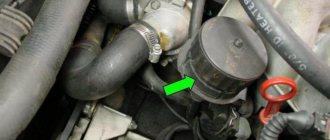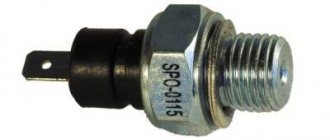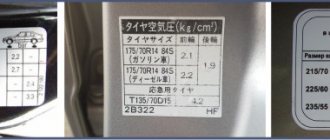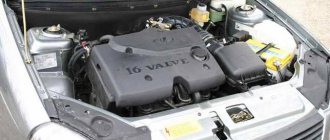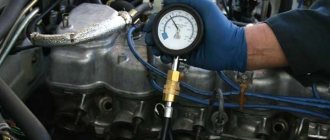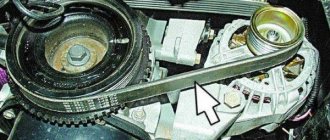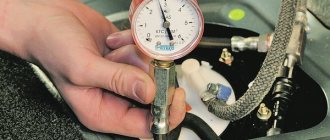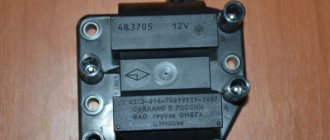As you know, for the VAZ-2114 engine to function normally, there must be normal compression in the cylinders. But not all motorists understand how to measure it and what should be the norm. This article will talk about the compression rate in the engine cylinders, as well as the reasons for the increase in the indicator and the measurement process.
Video about measuring compression on a VAZ-2114 with your own hands:
The video will tell you how to measure compression in a car.
Compression rate in the VAZ 2114 engine
Compression of a VAZ 2114 engine is the value of piston pressure at maximum compression of the working mixture. It can be normal, increased or decreased. This value depends on many factors and is measured in bars.
Normal compression in a VAZ 2114 engine is 14 bar . A decrease of no more than 3 bars is permissible. Moreover, it should be the same in all cylinders. Only a slight deviation of one bar is possible. Otherwise, immediate diagnosis and engine repair is required.
How to measure compression without a compression gauge
Is it possible to measure compression without a device? Practice shows that yes, it is possible. But this method will give relative and approximate readings. To measure the compression indicator without instruments, remove the spark plugs from all cylinders except the one being tested. Manually rotate the crankshaft until the compression stroke ends (watch the marks - they should match). Perform this operation on all cylinders one by one. Where the pressure is low, it will take less effort to turn the crankshaft. In this way, of course, you will not get accurate compression readings in the engine. But it is possible to understand the presence of problems.
It is recommended to measure compression every 20-30 thousand kilometers, so every car enthusiast is recommended to have his own compression gauge. Its price is not so high that it is worth saving on it.
The approximate price of a device for measuring engine compression in online stores in the capital is from 600 rubles to 2 thousand. Branded models from Western manufacturers are more expensive – up to 8 thousand. In the regions, a device for measuring compression costs no more than in the capital. Its price varies depending on the manufacturer.
Reasons for low compression
Most often, motorists ask the question of what compression should be in the VAZ 2114 when it is lowered. This phenomenon is more common than increased compression. And the main reasons for low compression are:
- Worn oil scraper rings. Over time, these motor elements wear out and need to be replaced.
- Burnt out valves. This usually happens when the engine overheats due to improper operation and untimely maintenance.
- Wear of the piston group. This can be determined when disassembling the power unit. It occurs from time to time or when the rules of operation and maintenance are violated.
- Incorrect valve adjustment. This causes the valve to fail to close, resulting in reduced compression.
- Clogged air filter. The motor does not receive enough air, which can also cause problems.
- Severe wear or breakage of the timing belt, or incorrect installation. If the belt slips, the valves of the VAZ 2114 do not bend. But this problem also leads to decreased compression.
- Cylinder head gasket failure. Gases enter the oil line or cooling system.
- Cracks in the cylinder head. This defect can be seen during visual inspection.
As mentioned above, how much compression should be, it should be the same in all cylinders. Even if in one of them it is significantly lower than required, this indicates a malfunction of the power unit and the need for its repair.
We carry out checks for an 8 valve car
So, the procedure for checking the motor yourself is not particularly difficult. Having the necessary skills and a device with which you can measure pressure, the procedure can be carried out independently. Naturally, for this you will have to follow certain requirements, which are listed below. If you know what the compression should be in the internal combustion engine, then you can start working.
Step by step instructions
The first thing you will need to measure the pressure level in the engine is a device with which you will do this. How can we measure this coefficient? The device for this is called a “compressometer”. Such a device can be of several types:
- universal device;
- threaded;
- flexible;
- clamping
This is what the pressure measuring device looks like disassembled
You will need to find such a device. Also, in this matter you will need the help of a friend, since you will have to simultaneously perform some actions both inside the cabin and in the engine compartment. In addition to the compression gauge, prepare a wrench for removing the spark plugs. Please note that it is better not to perform any work if the battery is not working. Therefore, fully charge your battery. So, let's start checking:
- First, get behind the wheel and start the engine. Let it idle and warm up to 90 degrees, that is, to operating temperature.
- After this, open the hood and take the key to remove the spark plugs. You need to remove the high-voltage wires, and then dismantle all the spark plugs. The wires fit to the spark plugs, you just need to pull them out.
- Now remove the ECU fuse to avoid possible damage to the device.
- When the spark plug is dismantled, you need to install your device in its hole to check the pressure level. Do this carefully so as not to damage the threads.
- Now you will need a friend's help. Ask him to sit in the driver's seat. The assistant must press the gas pedal all the way so that the throttle valve can open completely.
- Then turn on the starter and turn the crank pulley with it. This is done until the readings on the compression gauge stop increasing. As a rule, this takes no more than 10 seconds. In this case, the crank pulley must rotate, and its rotation speed should not exceed 100 rpm.
- Now you can read the received readings. Better write them down. Remember what the compression should be and compare these readings with the received ones. Once the readings are recorded, the device's needle can be set to zero.
- This procedure should be repeated for each cylinder of the VAZ 2114 8 valve engine.
As you understand, there is nothing particularly difficult in this procedure. You just need to carry out all the measuring steps correctly and you will get the most accurate results.
Causes of increased compression
When thinking about what the compression in an engine should be, it is important to understand that it should not be too high. And the reasons for this may be:
- Worn or stuck oil seals. You can see this problem without removing the cylinder head. When unscrewing the spark plugs, an oil film is visible in the spark plug wells. And it can be solved by replacing parts or decarbonizing them with chemicals.
- There is carbon deposits on the valves, carbon deposits in the throttle body and on the cylinder walls. It can be noticed when examining these parts.
- Errors in adjusting the gas distribution mechanism.
- Engine overheating.
How to measure compression correctly
Engine compression is measured with a fully charged battery. After charging and installing the power source in place, check the starter. It shouldn't create any problems either. Then warm up the engine. Its temperature during measurements should be 70-90°C.
It is necessary to unscrew all spark plugs from all holes. Also unscrew the fuel hose to stop the fuel supply. Prepare the compression gauge for use.
Compressometer
Signs of poor compression
You can understand that engine compression is not normal by the following signs:
- Misfires. You can notice by the unstable operation of the motor;
- Engine tripping. This symptom is heard when the power unit is operating;
- Decrease in dynamics. The car accelerates more slowly and lacks power;
- Engine knocking during operation;
- Increased oil consumption. The need to refill it more often;
- Difficulty starting. The engine is more difficult to start than before. Sometimes it may not start at all;
- Increased fuel consumption. Gasoline lasts for fewer kilometers than before;
- Black smoke from the exhaust pipe when starting the engine, which cannot be seen with the naked eye.
Increase compression
Yes, in some situations the compression can rise to 15 bar, which is not the norm. There is an explanation for this: all possible gaps are sealed with oil, there is no other liquid nearby. When engine oil splashes onto the piston group from below, the excess is removed from the walls by oil scraper rings. But when it comes from above, from the side of the combustion chamber, and even in large quantities, then it has nowhere to go. Part burns along with the fuel, causing white or bluish smoke to come out of the exhaust pipe, and the other part seals the cracks.
Oil enters the combustion chamber for the following reasons:
- valve oil deflectors (caps) have become unusable;
- After long-term use, the bushings inside which the valve stems move broke.
A good technician will eliminate the first reason without removing the engine head from the block by replacing the caps. The second will again require disassembly and pressing of new bushings.
Ways to increase compression
A decrease in compression does not always mean the need for a major engine overhaul. After all, it can arise for other reasons. Many of them can be eliminated with your own hands. To do this you need:
- Replace the air filter and spark plugs if they are in poor condition and have been changed for a long time.
- Adjust the valves;
- Replace oil rings. You can do this yourself by first assessing the condition of the old elements;
- Replace or correctly install the timing belt. This procedure is described in the article Timing timing marks on the VAZ 2114. Decarbonize the engine. Chemicals are used for this. They can be bought at any auto store. The composition is poured into the engine in accordance with the instructions. The chemical must remove carbon deposits and other contaminants on the engine walls. This will help him restore stable work.
Most operations can be done with your own hands. But, if they cause difficulties, it is recommended to contact a car service. If the above procedures do not work, the engine is likely very worn and needs a major overhaul. This usually happens with very high mileage or with insufficient engine care. In this case, you need to contact a service station to carry out capital repairs. Such repairs are not cheap, and timely maintenance of the car and elimination of minor faults will help to avoid it.
How to increase engine compression in other ways?
There are several options for raising compression without repair. These operations do not in any way guarantee an increase in compression, but you can try. But it is still recommended to eliminate the malfunction by mechanical action - eliminate the malfunction: replace the rings or replace the valves.
- Adjustment of valves. I tried it myself, it really works. The valve could be jammed and therefore not close, resulting in a compression leak.
- Roscoking – removes carbon deposits and excess oil in the cylinder. It only helps with stuck rings; if the valves are burnt out, there is no point in carrying out this operation.
What is the normal compression in the cylinders of an 8 valve VAZ-2114 engine?
As you know, for the VAZ-2114 engine to function normally, there must be normal compression in the cylinders. But not all motorists understand how to measure it and what should be the norm. This article will talk about the compression rate in the engine cylinders, as well as the reasons for the increase in the indicator and the measurement process.
Video about measuring compression on a VAZ-2114 with your own hands:
The video will tell you how to measure compression in a car.
Invalid compression values for the engine
At first glance, it may seem that the higher the compression parameters of the air-combustible mixture, the better. But actually it is not. Compression has an upper threshold that cannot be crossed, as this will lead to overheating of the engine, and, as a result, deposits of carbon deposits, excessive load on the pistons and rings, as a result of which engine parts may fail.
Low pressure in the engine leads to excessive consumption of fuel and oil. It is not permissible that in individual cylinders it differs sharply from neighboring ones. Different compression in the cylinders indicates serious problems in the engine - wear and defects that have appeared that require replacement or repair of parts.
Thus, bad compression is:
- increased,
- low,
- different.
All of these signs of poor compression are a sign that the heart of the car needs repair.
Correct compression (norms) for VAZ-2114
The process of measuring compression in engines
According to the regulatory and technical documentation, a limit value of compression in the cylinders of the VAZ-2114 engine has been established. Thus, an increase or decrease in the indicator is not considered normal, since excessive compression of the air-fuel mixture in the engine can lead to not very good consequences.
Also, it is worth noting that the compression in all cylinders should be relatively equal. Different indicators are not the norm and these are the first signs of a major engine overhaul.
Normal compression in the engine cylinder
As practice and many years of experience of motorists show, the compression in the cylinders should be 14 bar, but the lower limit should not fall below 11 bar .
When measuring, the difference in compression between the cylinders should not exceed 1 bar .
Example of a bad and normal compress
Let's give a clear example: 12-13-12-13 is normal compression for the engine, but 12-11-12-8 is not normal and it is believed that the engine needs diagnostics and major repairs.
Reasons for increasing compression
Compression gauge for replacing compression
It becomes clear that a decrease in compression in the engine is associated with wear of key elements, such as pistons and compression rings, main and connecting rod bearings, as well as valves. But what are the reasons for the increased compression?
So, let's look at the main ones:
- When performing repair operations related to the gas distribution mechanism, an error was made in the adjustment work , which changed the order of operation of the unit, and, accordingly, the compression in the cylinders.
- Heat on the valves , as well as the accumulation of carbon deposits on the cylinder walls and throttle assembly, leads to an increase in the compression ratio due to a decrease in space in the nodes.
- Also, the reasons for increased compression in the cylinders include engine overheating.
- The last reason for increased compression is the “occlusion” of the valve stem seals. The malfunction is diagnosed quite simply - the spark plugs are unscrewed and the oil wells are examined. An oil film indicates that there is an excess of oil and the need to replace the valve seals.
Signs of low compression and how to measure it on a VAZ engine
Compression on a VAZ 2114 should be measured every 30 thousand kilometers. This is usually done in conjunction with adjusting the valves. However, signs of low compression may not only appear during a routine check. During the operation of the car, signs of poor compression are detected quite simply, you just need to carefully monitor your engine. These are phenomena such as:
- The power of the internal combustion engine drops sharply;
- the engine troits, this can happen when low compression forms in one cylinder;
- Oil and gasoline consumption increases significantly.
Having discovered such signs, it is necessary to measure the compression in the engine. To carry out this procedure you need to prepare:
- before measuring compression in the engine, you need to fully charge the car battery and check the functionality of the starter, it must work without any problems;
- prepare a device for measuring compression, it is called a compression meter. It consists of a pressure gauge and a rubberized tube at the end of which there may be a threaded connection for screwing into the spark plug hole or a conical rubber tip that plugs this very hole like a plug;
- immediately before work, warm up the car, because the correct way to measure compression in the engine is to use a warm engine;
- Unscrew and remove all the spark plugs from the holes, placing them side by side in an accessible place. It is necessary to remove all the spark plugs, because if you unscrew only one and measure in this position, the compression level will not correspond to the true one;
- Turn off the fuel supply to the injectors by unscrewing the fuel hose.
When starting such work, you need to know what compression should be on the VAZ 2114. The normal pressure in the cylinders during compression should be 1.0 MPa; for an eight-valve engine in ideal condition it will be 1.4 MPa.
Having prepared properly to find out what the compression should be in the cylinders, install a compression gauge in the first cylinder.
Press the gas pedal all the way to fully open the throttle and thereby ensure maximum air flow. Then, turning the ignition key, use the starter to crank the crankshaft at speeds from 100 to 200 rpm for ten seconds. At this time, knowing what compression should be in the engine, it is necessary to monitor the readings of the pressure gauge of the measuring device installed in the spark plug hole:
- If the pressure initially increases slightly and then increases, then the piston rings are worn out. To verify this, just pour a little oil into this cylinder and measure again. The oil should plug the leak and compression should return to normal. This confirms that the rings need to be replaced;
- if the pressure increases to 0.8 MPa and then increases very slightly, then there are likely leaks in the valve or the cylinder head gasket is broken.
Carry out a similar procedure with measurements on all cylinders and record all readings. Upon completion of the work, install the spark plugs in place, connect the fuel hose and low-voltage wires. After cleaning the workplace, you need to analyze the records.
The pressure in the cylinders should not be lower than 1.0 mPa; this is the minimum compression indicator. The numbers for the cylinders should not differ much, no more than 0.2 MPa. If the compression reading in at least one cylinder is less than 1.0 mPa, a full check of the engine is required and, most likely, its repair.
You can do all this work yourself, or you can turn to specialists, you just need to find out in advance how much it costs to measure the compression in the engine. There are ways to increase compression in a VAZ engine without disassembling it. You can adjust the valves or decarbonize the engine.
conclusions
It was found that normal compression for a VAZ-2114 engine is 11-14 bar . An increase or decrease in this indicator, as well as a gap of more than 1 bar between the cylinders, is not considered normal and is subject to diagnosis. Engine compression is measured using a compression gauge.
There are several inaccuracies. Firstly, compression is traditionally measured with the engine not running at the starting speed generated by the starter! This is important: the pressure at the end of the compression stroke depends on the crankshaft speed, so if the engine is running, the compression will be much higher than the specified range - up to several times! Secondly, compression is measured on a warm engine (although there are some “former” ones who measure it on a cold engine, but the result is no more than a “funny letter”!). Third, the throttle must be fully open. Otherwise, the required amount of air will not be supplied, so the readings will be underestimated (there is nothing to compress!). On an injection engine, when the throttle valve is fully opened, the fuel supply and sparking stop (so-called cylinder purging). So there is no need to additionally turn off the ignition system (unlike carburetor engines). Fourthly, not only the absolute value of the pressure itself is important, but also how quickly it builds up. This indicator characterizes the condition no less accurately than the pressure itself. Ideally, a fixed value should be achieved in 2-3 “pumps”. And fifthly, the compression level is also affected by the condition of the starter and the flywheel ring gear: if the teeth are worn out and jammed, the compression value will also be underestimated. In general, for a more accurate assessment of the condition, the leak method is now much more often used.
Source
Different compression in the cylinders. Why and what to do? Let's look at the technical side.
Recently I was asked a question on my blog - why can there be different compression in the engine cylinders? The question, I’ll tell you the truth, is an interesting one, I personally asked myself this a long time ago when I was rebuilding the engine, but now it’s becoming less and less common because I drive more or less new cars. However, for those who have a mileage of 150 – 200,000 kilometers, this is dedicated to...
CONTENTS OF THE ARTICLE
I have already written a short article about engine compression. However, let me remind you a little - compression is the engine’s ability to build up pressure in the cylinder. This is done by moving the piston from the lowest point to the highest point, where the pressure is maximum. The piston is pushed by the connecting rod, which in turn is pushed by the crankshaft. So, this “pumping” occurs thanks to all kinds of gaskets, valves and rings that are attached to the piston and to the cylinder head. It is thanks to compression that the fuel ignites in the cylinders.
Compression in the cylinders of a VAZ 2114 engine 8 valves
The very concept of “compression” denotes the amount of pressure that the engine piston develops at maximum compression of the working mixture, that is, when it is at its lowest point. The higher this parameter, the higher the temperature the fuel-air mixture will burn, which means its consumption will decrease and the overall efficiency of the engine will increase.
The compression of the VAZ 2114, in fact, like the compression on any other car, depends on the following indicators:
- on the size of the clearance between the cylinder walls and the valves;
- on the volume of the incoming mixture, which, in turn, depends on the position of the throttle valve and the characteristics of the air filter;
- from the current engine temperature.
In turn, the size of the gaps between the cylinders and the elements of the piston group can also have a number of reasons:
- high degree of wear or burning of their walls;
- incorrectly set clearance between the cylinder walls and the valves;
- the entry of liquid gasoline into the cylinder (not in the form of a mixture), which causes the oil to be washed away from the walls and the clearance to increase.
Normal compression and its deviations
According to generally accepted standards, the compression of the VAZ 2114 8 valves should ideally be 14 bars (almost 14 atmospheres). The maximum permissible deviation to the lower side is 3 bars (that is, the compression value should not be lower than 11 bar).
True, this is only allowed if the compression value in different cylinders differs by no more than 1 bar. That is, the following compression schemes are acceptable in four cylinders: 12-12-11-12, 12-11-12-11 and so on. If the pressure difference exceeds 1 bar, then such an engine must be urgently repaired.
CORRECT COMPRESSION
How much compression should be in the engine for its long-term and trouble-free operation? Long-term practice of operating cars shows that ideally it should be 14 barrels in each cylinder. But a reduction to 11 barrels is allowed, provided that the difference in compression in the cylinders should be no more than 1 barrel. For example, a compression pattern of 11-12-11-12 is considered acceptable, but if the pressure in different cylinders is 11-12-11-9, or another combination of indicators that differs from normal, then the engine already needs repair.
What compression should be on a VAZ 2114 8 valve also depends on how long and under what conditions the car is operated. Ideal pressure, as a rule, occurs with a new engine, or one that has just come out of a major overhaul. During vehicle operation, compression may drop by 1-2 barrels. And this will also be within the normal range.
A new engine is the key to good pressure
Pressure measurements
We have already answered what the normal compression for a VAZ 2114 should be. Now let's look at how to actually measure it? First we need a special device called a compression meter.
All measurements using it are performed in the following order:
- Fully charge the battery.
- Warm up the engine to 75-90 degrees. WITH.
- After the engine warms up, remove all spark plugs.
- Disconnect the fuel supply hose.
- Insert the measuring device into the first spark plug hole.
- Press the gas pedal and hold it (to do this, two people need to take measurements).
- Start the starter and turn the crankshaft with it.
- Wait until the readings on the dial (monitor) of the device reach the maximum - this will be the compression value in a particular cylinder.
- Move the compression gauge to another spark plug hole and continue measurements.
After the pressure is measured in all cylinders, conclusions can be drawn about the general condition of the engine and the need for its repair/restoration.
If the compression is not normal, then you should stop driving the car and try to solve this problem first. Otherwise (especially if the pressure is very high), the engine may completely fail, after which it will need to be completely restored.
How to measure compression with a compression meter
A device consisting of a pressure gauge and a rubberized tube that measures compression in the engine is called a compression gauge.
The following devices are used:
- clamping,
- universal,
- flexible,
- threaded
Experts believe that of all types of compression gauges, it is better to use threaded ones. They provide more accurate information. It is necessary to measure the compression in the engine in each cylinder separately. The measuring instrument hose is inserted into the spark plug socket.
Now that everything is ready for measurements, start the engine and squeeze the gas all the way, let the engine run for a while. Check the pressure gauge readings and record them. Move the compression tester hose to the next spark plug hole, and take measurements in the second and subsequent cylinders in the same way. Write down all the results and compare them.
Measuring cylinder pressure without a compression gauge
Some motorists are wondering whether it is possible to check whether the compression in a VAZ 2114 8-valve engine is normal or not, without using special instruments.
The answer is yes. True, the results of such a measurement will not be accurate, but relative.
In order to check the condition of the cylinders without a compression gauge, you will need to remove all the spark plugs from the cylinders except one, which will be tested. Then you should manually turn the crankshaft. Then repeat a similar operation with the remaining three cylinders. Subjective sensations about the ease of rotation will be the result.
If, when testing one of the cylinders, the crankshaft rotates too easily, then this cylinder has reduced compression and significant wear. This can be confirmed or refuted by injecting a small amount of oil into the cylinder using a syringe.
If after this you have to rotate the crankshaft with significantly greater force, it means that the walls of the cylinder or piston have significant wear (since the oil has filled the gap and increased compression).
You can try to solve the compression problem on your own using one of the following methods: adjust the valves, decarbonize the engine (this will help remove carbon deposits that have settled on the walls) or replace the oil rings with new ones. If all these operations did not help, and the compression is still not up to standard, then the engine is seriously worn out and must be overhauled.
Handle the compressor correctly
Before you begin, you need to study the theory of how to use the device correctly and pay attention to the following:
- Before operation, the engine must be warmed up to a temperature no higher than 40-60 degrees Celsius. After this, you need to turn off the fuel supply.
- The battery must be well charged, the charge should be from 12 to 14 Volts.
- Air humidity should be low, so work can be carried out either outside in dry weather or in a heated, dry room with normal humidity.
- Before measuring, the spark plugs must be removed from all cylinders. The ignition must be turned off.
- Please note that compressors are produced differently and may not fit your engine model; this must be clarified before purchasing the device. The fact is that conventional measuring instruments have a short tip, and they are not suitable for 16-valve units.
- Measure compression with a pressure gauge twice. In one case the throttle valve must be fully open, in the other it must be closed. The difference needs to be compared. Ideally, the same compression will be detected in the engine cylinders; the norm is not observed if in one case the indicator is sharply higher, since this means that the engine needs repair.
- It is worth noting that a small error between different cylinders is acceptable, this is due to their uneven wear, but the difference should not be too large.
If you notice that your engine is running worse, then it may be time to check the engine compression level. What should be the compression of VAZ 2114 8 valves? How can I check it? We will tell our readers about this in this article.
Instructions for checking compression of VAZ-2109
To measure compression, you need to prepare special tools:
- a compression gauge consisting of a soft bendable hose, a pressure release key and a tip with a measurement panel;
- spark plug key.
When diagnosing yourself, you cannot do without an assistant. Instructions for measuring compression of a VAZ-2109 injector and carburetor look like this:
- Turn on the car engine and heat it to a temperature of 80 to 90 degrees.
- Remove the hose from the fuel pump that drains gasoline.
- Carefully unscrew the spark plugs, first clearing the wells of any build-up of dirt and debris.
- Remove the armor wire located in the center from the toggle switch cover, fix the spark plug in it and place it on top of the engine.
- Place the compressor tip in the recess of the first cylinder; the device does not have to be screwed in; it can be pressed against the hole with your hands.
- Proceed to measure pressure. The assistant must take the driver's seat and press the gas pedal all the way, then turn the key in the ignition and start the starter for at least 3-5 seconds.
- Watch how the compression meter values change at this time, the dynamics of increasing readings should be recorded, and also write down the maximum position of the arrow. Once locking is complete, release the pressure by pressing the release button.
- These actions must be performed for each engine cylinder separately, so as not to forget the indicators, record them on a piece of paper.
Video from Andrey Omikov “Measuring compression on your own”
See how the procedure for independently measuring the pressure level at home takes place using the example of a VAZ 2115.
To perform compression measurement work, you will need an assistant and a compression gauge.
- The first step is to check and, if necessary, adjust the timing valve clearances.
- Then you need to warm up the engine to operating temperature and turn it off.
- After this, you need to remove the fuses of the ECU and engine control system circuits.
- We unscrew the spark plugs.
We install a compression gauge in one of the cylinders.- We ask an assistant to press the gas pedal to the floor and turn on the starter for 5-10 seconds.
- We record the compression gauge readings.
- In the same way we measure the compression in the remaining cylinders. On a working engine, the compression in the cylinders should be at least 1.0 Μ Pa (10 bar), and the difference in compression between the cylinders should be no more than 0.1 MPa (1.0 bar).
- If there is less compression in one of the cylinders, then you need to pour about 10 m3 of engine oil into it.
- Check the compression on this cylinder again. If the compression has become greater than it was, then most likely the problem is in the rings or wear on the pistons. If the compression remains the same low, the cylinder head gasket may be faulty or the valves are not closing well.
Abnormal indicators
As you probably could have guessed, this is when in one of the four cylinders the pressure is significantly different from the others, for example in one it is 5.0, and in the others it is 9.5 atm. YES and the engine will not work stably. There are abnormal indicators in two and even three or four “pots”. But this already means that your engine is almost dead and needs to be overhauled!
So why does this happen - when in one the pressure is much less than in the others? There may be several reasons for this, all from my experience, but you almost always need to remove the cylinder head:
1) The gasket is broken . This happens very often when the gasket between the block and the block head breaks - we just replace it.
2) The head is not tightened . This is a continuation of the first reason - if the head is not tightened correctly, the gasket can also leak pressure.
These are the simplest reasons, but they are the most common - for example, this often happened on my new purchased VAZs, in particular on a VAZ 2114 and a friend on a VAZ 2110. So, first of all, we go there, on new "our brands" - the problem This will be 80%. Then there are more complicated problems.
1) O-rings leak . This happens due to wear and tear, or because they are broken. However, if the pressure has dropped in one of the cylinders, then it is most likely broken. The repair is complicated, you need to disassemble the block itself to remove the pistons.
2) The rings are coked . I decided to put it in a separate section - low-quality motor oil can cause the rings to become coked.
The oil simply burns at the points of contact and seals the rings in one place - although this is not correct, the rings do not move along their grooves, and only one side is machined, which leads to rapid wear - although in this way the pressure will drop in all 4 cylinders. Because oil lubricates all 4 pieces.
3) Wear of the block wall . This is rare - but it does happen, that is, the ring has nothing to do with it, but it is the walls that they rub against that suffer. Most likely, this is low-quality material.
4) Engine overheating . When overheated, the tightness of the rings and walls of the block is lost, they begin to leak both pressure and engine oil. An indirect sign is blue smoke from the exhaust pipe during operation.
5) Burnt out - the piston itself broke . In such cases, compression may simply drop to “zero”.
Sometimes the piston itself burns out, it can be a small “burnout” on the side, or a very large one – for example, in the middle. It also happens that the piston breaks, for example from meeting a valve when the timing belt breaks - again we lose atmosphere.
6) Valves . There are many reasons for this. This is also an incorrect adjustment. And it happens that a valve burns out - only one burns, so the compression will vary in exactly one cylinder. It can also break if the timing belt breaks.
These are the main reasons why the values will differ in exactly one pot out of all four.

